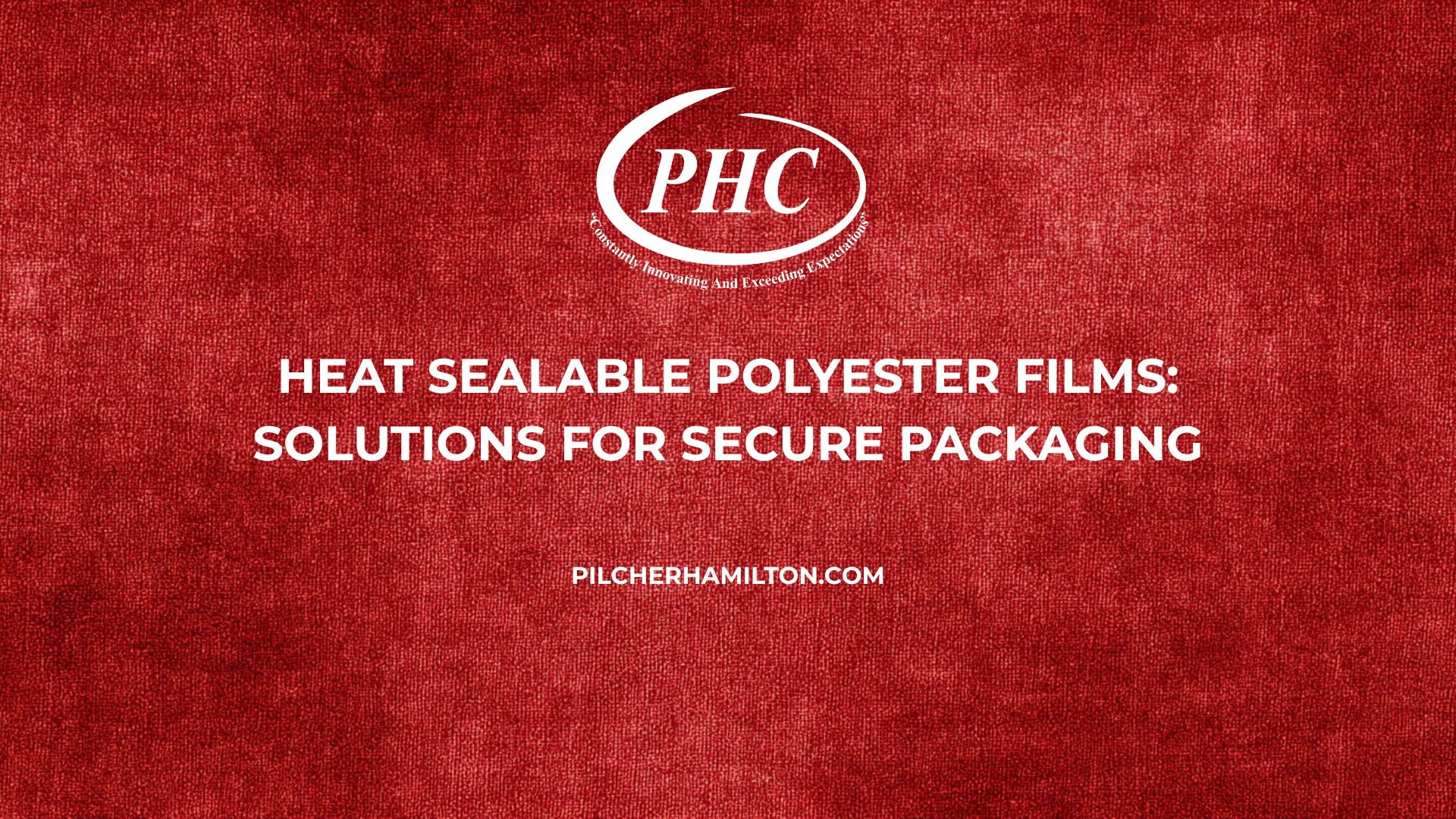Packaging engineers and buyers searching for polyester near me are usually trying to solve two problems at once: how to lock in reliable seals at high speed—and how to maintain clarity, stiffness, and dimensional stability across wide operating windows. Heat sealable polyester films (HSPET/BOPET with coextruded or coated seal layers) deliver consistent seal initiation, strong hot-tack, and excellent machinability for pouches, lidding, and flow-wrap. Pilcher Hamilton Corporation (PHC), at 850 South Buncombe Road
Greer – South carolina, supplies and converts heat-sealable PET to exact specifications, pairing material selection with precision slitting, sheeting, winding, coating, and corona treatment so your lines run fast and the seals hold.
Key Takeaways
- Seal windows can be engineered to 180–260 °F (82–127 °C) seal initiation (SIT), with typical operating ranges 250–350 °F (121–177 °C) depending on structure.
- COF tuned for form-fill-seal stability (typ. 0.30–0.55) and tailored to web path and jaw pressure/time.
- Gauges commonly 48–200 gauge (12–50 µm) for face webs; heavier gauges for stiffness or lidding.
- Surface energy on print/lam sides targeted at 42–50 dynes/cm to hold graphics and interlayer bonds.
- PHC provides specification support plus converting services: see All Services and reference Film Specs.
Heat Sealable PET Overview
What it is. Heat sealable polyester is PET (often biaxially oriented—BOPET) with a seal layer added by coextrusion or coating. The seal layer (e.g., modified PET, copolyester) provides a lower SIT and adequate hot-tack while the PET core preserves clarity, modulus, and dimensional stability.
Where it’s used. Flow-wraps, fin seals and lap seals, stand-up pouches (as reverse-printed webs laminated to sealants), and lidding films where clarity and puncture resistance matter. HSPET is frequently part of a laminate structure—for example, PET (print) // adhesive // HSPET for mono-PET paths, or PET (print) // adhesive // PE where sealant is provided by polyethylene.
Why PET. Compared with polyolefin-only films, polyester film maintains register at speed and resists heat-induced shrink in sealing jaws—reducing wrinkles, mis-seals, and graphics distortion. PET also provides a higher softening point, supporting wider process windows.
Seal Strength, Windows, and Line Settings
Understanding the seal window
- SIT (Seal Initiation Temperature): The temperature where a measurable seal begins—commonly 180–260 °F (82–127 °C) for common HSPET layers.
- Operating window: The range delivering robust seal strength (ASTM F88 or agreed method) and good hot-tack without distortion—often 250–350 °F (121–177 °C) depending on dwell and pressure.
- Hot-tack: The seal’s ability to resist opening while still hot—important for vertical form-fill-seal (VFFS) and heavy fills.
Typical machine settings (guide values)
- Jaw temperature: 275–330 °F (135–166 °C) for many snack/flow-wrap structures.
- Dwell time: 0.3–0.7 s depending on web speed and caliper.
- Jaw pressure: Typically 30–60 psi; confirm with equipment supplier and seal geometry.
Note: Optimize COF to balance draw control vs. drag. PET webs typically specify 0.30–0.55 film/film to maintain traction without chatter.
Packaging Applications
Flow-Wrap & Fin Seals
HSPET enables strong, flat seals with high-gloss clarity. Reverse-printed polyester packaging films laminated to HSPET or PE deliver premium shelf appeal. See PHC’s packaging lineup overview for PET options.
Lidding Films
For trays and thermoform packs, HSPET lidding maintains stiffness for die-cut accuracy and clean peel when engineered for peelable seal chemistries.
Barrier Laminations
When oxygen/light barrier is required, combine HSPET with metallized PET or PVDC-coated PET to hit OTR/WVTR targets while keeping PET’s handling benefits.
Graphics-Driven Pouches
Use acrylic-coated PET for permanent high dyne on the print face (Acrylic Coated), then laminate to HSPET for sealing performance—graphics stay crisp through filling and distribution.
Pros and Cons vs. Alternatives
| Criterion | Heat Sealable PET | Polyolefin Sealant (PE/CPP) | BON (Nylon) Laminate |
| Seal Initiation | Low SIT with modified PET layer | Low SIT; very forgiving | Requires sealant tie layer |
| Stiffness/Modulus | High (excellent layflat) | Lower (can wrinkle) | High puncture, good toughness |
| Clarity/Gloss | Excellent | Good–Very Good | Good |
| Heat Resistance | High; stable in jaws | Moderate | High |
| Barrier (OTR/WVTR) | Needs laminate barrier | Needs laminate barrier | Needs laminate barrier |
| Recyclability Path | Mono-PET possible | PE-dominant streams | Multi-material |
Choose HSPET when you want high speed, high clarity with seal assurance on vertical or horizontal lines. For deep-draw or puncture-critical packs, consider PET/BON/PET with a sealant layer (see BON + PET laminations).
Engineering the Surface: Dyne Levels & Treatments
- Print/lam side: Target 42–50 dynes/cm. Corona-treated PET supports wetting for inks/adhesives; acrylic-coated PET locks in higher dyne persistently.
- Seal side: Usually untreated; chemistry provides low SIT and hot-tack. Where peelability or anti-block is needed, specialized topcoats can be engineered.
- Coefficient of Friction: Specify static/dynamic COF and test method (e.g., 12 in/min) to stabilize web handling.
Buyer’s Checklist (Order-Ready Inputs)
- Structure: mono-PET (PET//HSPET) vs. PET//sealant (e.g., PE).
- Gauge: 48, 75, 92/100, 150, 200 gauge based on stiffness and puncture needs.
- Barrier target: add metallized or PVDC-coated PET as needed.
- Print face: corona vs. acrylic; dyne target 42–50+ dynes/cm.
- COF range: 0.30–0.55 (film/film) for your web path.
- Seal window: SIT target and jaw temp/dwell/pressure range.
- Roll build: width, OD, splice policy, 3″/6″ cores, orientation (seal side in/out).
- Required services: Slitting, Sheeting, Winding, optional Coating.
- Documentation: request Technical Datasheets and agreed test methods.
Specification Table: Representative Heat-Sealable PET Options
| Parameter | HSPET-A (Flow-Wrap) | HSPET-B (Pouch Web) | HSPET-C (Lidding) |
| PET Gauge | 12–19 µm (48–75g) | 19–25 µm (75–100g) | 25–36 µm (100–140g) |
| Seal Layer | Coex copolyester | Coex copolyester (higher hot-tack) | Peelable copolyester |
| SIT (°F/°C) | 200–230 / 93–110 | 200–240 / 93–116 | 210–250 / 99–121 |
| Typical Jaw Temp | 275–315 °F (135–157 °C) | 290–330 °F (143–166 °C) | 300–340 °F (149–171 °C) |
| COF (film/film) | 0.35–0.50 | 0.30–0.45 | 0.35–0.55 |
| Print/Lam Face | Corona 42–46 dynes/cm | Acrylic 48–54 dynes/cm | Corona/primer 44–50 dynes/cm |
| Notes | High speed HFFS | Reverse-print laminations | Clean peel options |
Values are guide ranges. PHC tunes to your adhesive, inks, dwell, and line speed.
Innovation in Sealing: Where PET Is Going Next
- Mono-PET structures: HSPET enables all-PET laminates (PET//HSPET) to simplify recycling streams where supported.
- Functional coatings: Anti-fog for produce, anti-static for electronics, and matte/gloss effects for branding—see Coating for options.
- Barrier upgrades: Pair with metallized polyester films or PVDC-coated PET to hit tough OTR/WVTR specs while keeping PET’s stability.
- Sustainability: Explore post-consumer recycled (PCR) PET for content goals without sacrificing line performance.
FAQ
Q1: What’s the difference between heat sealable PET and regular PET?
Regular PET needs a separate sealant (PE/CPP). Heat sealable PET integrates a copolyester seal layer to lower SIT and provide hot-tack, enabling direct sealing to itself or compatible substrates.
Q2: How do I choose the right SIT and jaw temperature?
Start from the SIT and build a process window with your line’s dwell and pressure. For many webs, 275–330 °F (135–166 °C) jaws and 0.3–0.7 s dwell are productive—verify against your structure and product.
Q3: Can heat sealable PET be peelable?
Yes—peelable copolyesters tailor peel force (e.g., 200–600 g/25 mm target) for lidding and easy-open packs.
Q4: How does COF affect sealing and throughput?
COF 0.30–0.55 helps manage traction and slip. Too low COF can cause web creep in the jaws; too high can trigger chatter or jams. Specify method and target with your order.
Q5: Where can I find polyester near me that’s heat-sealable and press-ready?
PHC supplies heat sealable polyester films nationwide from Greer, South Carolina—with converting services to deliver press-ready rolls and predictable seals.
Talk to PHC About Heat-Sealable PET
If you’re qualifying pouches, lids, or flow-wrap and searching for polyester near me, Pilcher Hamilton Corporation can help you specify heat sealable polyester films that hit your seal window, graphics quality, and throughput targets. Explore All Products, review our Film Specs, or Contact Us to start a spec review.
Pilcher Hamilton Corporation
850 South Buncombe Road
Greer – South carolina

